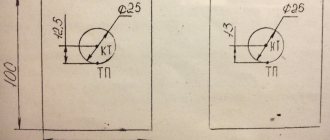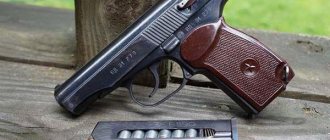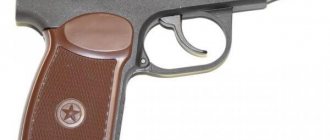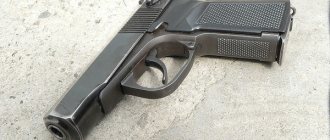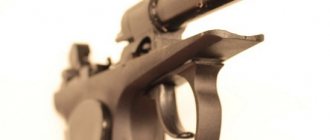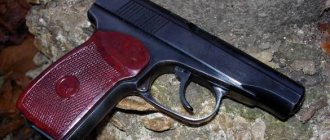PURPOSE OF PM PARTS AND MECHANISMS
Frame with barrel and trigger guard:
- barrel - serves to direct the flight of the bullet;
- frame - serves to connect all parts of the gun;
- base of the handle - serves for attaching the handle, mainspring and for storing the magazine;
| Ejector |
| Gnetok |
| Ejector spring |
- trigger guard - serves to protect the trigger from accidentally pressing it.
| Fuse |
| Drummer |
| Gate |
The bolt is used to feed a cartridge from the magazine into the chamber, locking the bore when firing, holding the cartridge case in the bolt cup and cocking the hammer.
- striker - serves to break the capsule;
- ejector - serves to hold the cartridge case in the bolt cup until it meets the reflector;
- safety - serves to ensure safe handling of the pistol.
Return spring - serves to return the bolt to the forward position after firing.
Bolt stop - holds the bolt in the rear position after all the cartridges from the magazine have been used up.
Magazine - serves to hold 8 rounds.
Handle with screw - covers the side windows and the rear wall of the base of the handle and serves to make it easier to hold the pistol in your hand.
Shock trigger mechanism:
- trigger - used to strike the firing pin;
- sear with a spring - serves to hold the trigger on the combat and safety cock;
- trigger rod with cocking lever - used to release the hammer from cocking and cocking the hammer when pressing the tail of the trigger;
- trigger - used to release the hammer from cocking and cocking the hammer when firing by self-cocking;
- mainspring - serves to actuate the hammer, cocking lever and trigger rod;
— mainspring latch—serves to attach the mainspring to the rear wall of the base of the handle.
DELAYS WHEN FIRING FROM PM AND WAYS TO ELIMINATE THEM
| DELAYS | REASONS FOR DELAY | WAYS TO ELIMINATE DELAYS |
| 1. Misfire. The shutter is in the extreme position. The trigger is pulled. There was no shot. | 1. Cartridge primer is faulty 2. Grease thickening. or contamination of the channel under the firing pin. 3. The output of the striker or nick on the striker is small. | 1. Reload the pistol and continue shooting. 2. Inspect and clean the gun. 3. Send the gun to the workshop. |
| 2. Failure to cover the cartridge with the bolt. The shutter stopped when it reached its extreme forward position. The trigger cannot be pulled. | 1. Contamination of the chamber, frame grooves and bolt cup. 2. Difficult movement of the ejector due to contamination of the ejector spring or pressure. | 1. Push the bolt forward with a push of your hand and continue shooting. 2. Inspect and clean the gun. |
| 3. Failure to feed or advance the cartridge from the magazine into the chamber. The bolt is in the forward position, but there is no cartridge in the chamber; the bolt has stopped in the middle position along with the cartridge, not sending it into the chamber. | 1. Contamination of the magazine and moving parts of the gun. 2. Bent upper edges of the magazine body. | 1. Reload the pistol and continue shooting. Clean the gun and magazine. 2. Replace the faulty magazine. |
| 4. Sticking, pinching of the cartridge case by the bolt. The cartridge case was not thrown out through the window in the bolt and became wedged between the bolt and the breech end of the barrel. | 1. Contamination of the moving parts of the gun. 2. Malfunction of the ejector, its spring or reflector. | 1. Throw away the stuck cartridge case and continue shooting. 2. If the ejector with a spring or reflector malfunctions, send the gun to a workshop. |
| 5.Automatic shooting. | 1. Thickening of the lubricant or contamination of parts of the trigger mechanism 2. Wear of the cocking mechanism or sear nose. 3. Weakening or wear of the sear spring. 4. Touching the shelf of the fuse ledge of the sear tooth | 1.Inspect and clean the gun. 2. Send the gun to the workshop. 3. Send the gun to the workshop. 3. Send the gun to the workshop. |
Design of a Kalashnikov assault rifle (AKM, AKSU-74)
Rice. 42
1. Barrel with receiver with sighting device, butt and pistol grip (and receiver cover for AKS-74U); 2. Receiver cover; 3. Bolt carrier with gas piston; 4. Shutter; 5. Return mechanism; 6. Trigger mechanism (located inside the receiver); 7. Gas tube with receiver lining; 8. Forend; 9. Shop; 10. Cleaning rod; 11. Muzzle brake-compensator for AK-74 and flash suppressor for AKS - 74U; 12. Bayonet; The AK kit includes: 13. Belt; 14. Bag for shops. 15. Accessories (wiping, brush, screwdriver, drift); 16. Oil can.
Rice. 43
PURPOSE, performance characteristics, DEVICE, AND PRINCIPLE OF OPERATION 5.45 (7.62) MM KALASHNIKOV AUTOMATIC
The Kalashnikov assault rifle is an individual weapon and is designed to destroy manpower and destroy enemy fire weapons.
The machine consists of the following main parts and mechanisms:
- barrel with receiver with sighting device, butt and pistol grip (receiver covers for AKS - 74U);
- receiver covers (For the AKS-74U assault rifle, the receiver cover is attached to the receiver);
- bolt frame with gas piston;
- shutter;
- return mechanism;
- trigger mechanism;
- gas tube with receiver lining;
- forend;
- store;
- muzzle brake-compensator for AK-74. and flash suppressor for AKS - 74U;
- ramrod. (AKS-74U has a cleaning rod included in the kit);
- bayonet-knife (AKS-74U is not included).
The machine kit includes: accessories, a belt, three spare magazines, four clips, an adapter and a bag for carrying magazines and accessories, a case for the machine (AKS-74, AKMS, AKS - 74U).
The automatic operation of the machine is based on the use of the energy of powder gases diverted from the barrel bore into the gas chamber.
When fired, part of the powder gases following the bullet rushes through the hole in the barrel wall into the gas chamber, presses on the front wall of the gas piston and throws the piston and bolt frame with the bolt to the rear position. When the bolt frame moves back, the bolt is unlocked, the bolt removes the cartridge case from the chamber and throws it out; the bolt carrier compresses the return spring and cocks the hammer.
The bolt frame with the bolt returns to the forward position under the action of the return mechanism, while the bolt sends the next cartridge from the magazine into the chamber and locks the barrel, and the bolt frame removes the self-timer sear from under the cocking of the self-timer trigger. The trigger is cocked. The bolt is locked by turning it around the longitudinal axis to the right, as a result of which the bolt lugs extend beyond the lugs in the receiver.
If the translator is set to automatic fire, then shooting will continue as long as the trigger is pressed and there are cartridges in the magazine.
If the translator is set to single fire, then only one shot will fire when the trigger is pulled. To fire the next shot, you must release the trigger and press it again.
TACTICAL-TECHNICAL, WEIGHT AND LINEAR DATA of AK-74, AKM and AKS-74U
| TTX AK | AK-74 | AKM | AKS – 74U |
| Sighting range, m | up to 1000 | up to 1000 | up to 500 |
| Most effective fire, m | up to 500 | up to 500 | up to 400 |
| Range of a direct shot at the chest figure, m | |||
| by height, m | |||
| Rate of fire rounds per minute | 650-700 | ||
| Combat rate of fire rounds per minute: | |||
| when firing single shots | |||
| when firing in bursts | |||
| Initial bullet speed, m/s | |||
| Lethal effect of a bullet, m | up to 1350 | up to 1500 | up to 1100 |
| Maximum bullet flight range, m | |||
| Machine weight, kg | |||
| With an empty magazine | 3,3 | 3,1 | 2,7 |
| With loaded magazine | 3,6 | 3,6 | 3,0 |
| Magazine weight, kg | 0.23 | 0,17 | 0,215 |
| Caliber, mm | 5,45 | 7,62 | 5,45 |
| Machine length, mm | |||
| in a combat position with the butt folded back | |||
| in stowed position (AKMS, AKS-74) | |||
| Barrel length, mm | 206,5 | ||
| Length of the rifled part of the barrel, mm | 164,5 | ||
| Number of grooves, pcs. | |||
| Cartridge weight, g | 10,2 | 16,2 | 10,2 |
| Weight of bullet with steel core, g | 3,4 | 7,9 | 3,4 |
| Powder charge mass | 1,45 | 1,6 | 1,45 |
PROCEDURE FOR CLEANING AND LUBRICATION OF AK.
Disassembly of the machine can be complete or incomplete. Complete disassembly of the machine is carried out for cleaning when the machine is heavily soiled, after it has been exposed to rain, sand or snow, when switching to another lubricant or during repairs. In all other cases, incomplete disassembly is performed.
Disassembly and assembly of the machine is carried out on a table or on a clean mat. Parts and mechanisms are stacked in the order of disassembly. They should be handled with care, do not place one part on top of another and do not use excessive force or sharp blows.
Makarov pistol (PM) - additional information
Makarov pistol (PM)
Soviet (Russian) 9mm pistol for the army, police and special services
An automatic 9mm pistol developed in 1948 by Nikolai Makarov. Due to the simplicity of the device, the reliability of the design and the ease of use of the pistol, its production continued for more than 50 years, during which time more than 2 million copies were produced in the USSR alone. However, in the mid-1990s, a modernized version of the PM - PMM - lost the competition to the Yarygin pistol (YA) as a standard weapon for Russian security forces.
A competition for the development of a new pistol to replace the 7.62 mm TT model 1933 was announced in the USSR in 1945. According to the terms of the competition, the new pistol had to exceed the TT in terms of weight and size and reliability, have a caliber of 7.65 or 9 millimeters, have a greater stopping effect and no less destructive power than its predecessor.
N.F. Makarov
The winner of the competition was a pistol designed by a team of engineers led by Nikolai Fedorovich Makarov (1914-1988). The Makarov pistol won the competition with the developments of the leading rifle design bureaus of the Soviet Union - Tokarev and Simonov. The preliminary design of the PM was completed in 1947. In 1948, the final version of the project was prepared.
Production of the new pistol began in Izhevsk in 1949 and continued for more than 50 years. The Makarov pistol, or PM, was officially adopted into service by the Soviet army, the Ministry of Internal Affairs and state security agencies in 1951.
The PM is built according to the scheme used in the German Walther Polizei Pistole (Walther PP). Automation operates on the principle of blowback - the simplest and most reliable, but with limitations on the power of the cartridge. The bolt return spring fits directly onto the barrel, and there is a notch on both sides of the rear part of the bolt casing for manual reloading.
The PM trigger mechanism is double-action (self-cocking), with an open hammer, which allows you to remove the pistol from the safety, cock the hammer and fire using only one hand. The design of the PM consists of only 25 parts, which increases the reliability of the gun and simplifies its maintenance and repair.
Characteristics of the Makarov pistol
| Cartridge | 9x18 millimeters |
| Principle of operation | automatic based on blowback recoil, self-loading |
| Nutrition | 8-round box magazine |
| Weight without cartridges | 0.73 kilograms |
| Weight with loaded magazine | 0.81 kilograms |
| Weapon length | 161 millimeters |
| Height | 126.75 millimeters |
| Width | 30.5 millimeters |
| Barrel length | 93 millimeters |
| Rifling | 4 (right-hand) |
| Initial bullet speed | 315 meters per second |
| Combat rate of fire | 30 rounds per minute |
| Sighting range | 50 meters |
The reduction in size and weight of the PM compared to the TT pistol made it easier to carry the pistol concealed, which made it possible to use it in the criminal police and intelligence services. A more comfortable grip and a fixed PM barrel ensured sufficient shooting accuracy.
Thanks to its reliability, ease of use and ease of maintenance, the Makarov pistol remained in production for almost fifty years with virtually no changes in design. Only in the late 90s was the PMM (modernized Makarov pistol) put into mass production with a more powerful cartridge and a magazine of increased capacity (12 rounds).
The Makarov pistol was created for the new 9mm cartridge 9x18 (18 is the length of the cartridge case in millimeters). In terms of muzzle energy and muzzle velocity (300 joules, 315 meters per second), the PM cartridge took an intermediate position between the most common 9-mm ammunition at that time - 9x17 Kurz, for which, in particular, the Walther PP pistol was built, and 9x19 Para , used in more powerful military pistols.
In addition to the listed advantages, PM has some disadvantages, partially resulting from them. Reducing the barrel length to 10.3 calibers, coupled with the simplest sighting devices, led to a decrease in shooting accuracy. In addition, the vast majority of PMs require additional zeroing for a specific shooter in order for their accuracy to correspond to the table. The actual effective firing range of the PM does not exceed 25 meters, which is sufficient, in principle, for a police pistol, but clearly not enough for an army pistol.
However, for a long time PM had no alternative. Some special forces of the army, the Ministry of Internal Affairs and the KGB were armed with Stechkin automatic pistols - APS, also created for the 9x18 cartridge, but the vast majority of law enforcement officers who were assigned pistols used the Makarov as their service weapon.
In total, almost two million Makarov pistols were produced in the USSR. In addition, the PM was produced in China (type 59), in the GDR (9-mm M), in Yugoslavia - M-67 chambered for 7.65 and 9 mm calibers. In general, the PM is not widely used - outside the CIS it is in service with 12 states, mainly belonging to the “third world” countries.
By the mid-90s, the shortcomings of the PM both as an army and as a police pistol in comparison with the best foreign models became obvious. In order to retain the market, the designers of the Izhevsk plant, as part of the Grach project competition, developed a modernized version of the pistol - PMM. The new pistol is equipped with a double-row magazine of increased capacity (12 rounds) and has increased power ammunition. The 9x18 PMM cartridge retains the dimensions of the PM cartridge, but due to a more powerful charge it has a higher initial speed - 430 meters per second. However, the increase in power came at the cost of the pistol's reliability - in some cases, cartridges are deformed when fired, which complicates their extraction and leads to delays during shooting. As a result, the PMM lost the competition to the Yarygin pistol - PYa, which was adopted by the Russian Army in 2003 (mass entry into the army began in 2011).
In addition to the PMM, a number of other modifications were created on the basis of the PM in the 90s, the most famous of which is the IZH-71 service pistol chambered for the less powerful 9x17 Kurz cartridge, used by private security companies.
Due to their prevalence, low price and reliability, the Makarov pistol and its derivatives have also gained popularity in the criminal world. Thus, on September 13, 2006, Deputy Chairman of the Bank of Russia Andrei Kozlov was killed using a PM pistol (converted from a pneumatic version to a combat one). On October 7 of the same year, the Izh-71 pistol became the weapon used in the murder of journalist Anna Politkovskaya.
According to media reports, on the “black market” a “clean” (not used in crimes) Makarov pistol can be purchased at a price of $600 to $1,000.
PHOTOS AND ADDITIONAL INFORMATION ON THE TOPIC:
One of the first serial PMs produced in 1949, the distinctive features of which are figured frames, a protrusion on the right side of the trigger guard and magazines with an oblique protrusion for turning off the bolt stop.
Magazine for the PM pistol.
The Makarov pistol, manufactured in 1954, still has a shaped front part of the frame.
Makarov managed to almost completely eliminate delays in firing caused by sticking the cartridge into the bevel of the chamber. The designer managed to achieve an ideal relationship between the height of the upper cartridge, the geometry and inclination of the chamber bevel, the shutter-casing mirror and the ejector design. With the PM, the upper cartridge in the magazine is located very high, almost at the level of the chamber, as a result of which, with the other above-mentioned features, the cartridges are fed at a minimum angle and the risk of sticking is minimized. The same Walter PP is very “picky” about the shape of the bullet of the cartridges used due to the low location of the upper cartridge in relation to the chamber. The reliability of the PM thanks to this design has been proven not only in tests, but most importantly, in real combat operations.
PM manufactured in 1972 with a clip and standard packs of 16 rounds.
PM pistol manufactured in 1977.
The IJ70-17A pistol is an export version of the PM, using 9×17 cartridges, equipped with a vertically and horizontally adjustable rear sight and wide rubber grip cheeks. Attached to the front of the trigger guard is a laser designator, which became a particularly fashionable weapon accessory in Russia in the 1990s.
The very first PMs were produced in Tula in a trial batch of 20 to 30 pieces. The numbers began with “TM”, followed by numbers and the year. After this, the production of Makarov pistols was moved to Izhevsk, where in 1949 a test batch of 5,000 copies was made, with numbers starting with “TM”. Early pistol frames (1949 - 1953) are distinguished by a shaped front part, and the trigger guard has a protrusion on the right side of the upper edge. The side protrusion of the trigger guard, when pulled down, opened access to the trigger, making it possible to remove it. In 1949, the pistol number was stamped on the rather wide front lower end of the bolt casing. In later versions, numbers were placed on the left side of the bolt casing and frame. The slide stop at the bottom had a release lever, also called a tooth. After the last cartridge was used up, the bolt-casing was placed on the bolt stop, and at the moment the loaded magazine was attached, the lever (tooth) of the bolt stop, interacting with the inclined protrusion of the window on the left side of the magazine, released the bolt-casing, sending the cartridge into the chamber. In order to ensure greater safety in handling weapons, the lever that automatically turns off the bolt stop was subsequently abolished. Now, in order to release the bolt casing with the magazine removed or attached, you need to press the outer protrusion of the bolt stop. Such a reduction in the combat qualities of the weapon, increasing the reloading time, is, of course, a controversial decision, but justified by the practice of operation in the army. The rear wall of the base of the handle of the PM frame produced in 1949 has a flat surface and does not have a bracket for clamping the mainspring, which is held directly by the handle and screw. Since 1950, the shape of the rear surface of the base of the handle has been changed due to the fact that the fastening of the screw holding the mainspring and the cheeks of the handle was constantly weakening.
In 1950, production of the same shaped frames began, but with the base of the handle having a mount for the mainspring clamp bracket and the clamp itself. Pistols manufactured in 1949 were equipped with grip cheeks with a diamond-shaped cross notch on the back surface, the color of which could be either black or brown. Later ones have a smooth back surface, and only a red-brown color with various shades of it. From the second half of 1953, pistols with a modified trigger pull shape and reduced trigger free play began to be produced, as well as transitional models with a shaped frame, a bracket for clamping the mainspring, and a trigger guard that does not have a protrusion. In 1954, the configuration of the safety lever lever changed slightly. From the same year, production of a new type of frame began, with a thin front part, which is used to this day. In 1970, a reduced firing rate was adopted - from 5,000 to 2,500 rounds. In 1984, in order to ensure more convenient handling of the weapon, the number of notches on the left surface of the bolt casing was increased from ten to thirteen. Since 1988, the lever of the safety lever began to be manufactured using the method of casting in a mold and subsequent processing by milling. Around 1989 the quality of workmanship deteriorated. The shape of the bolt stop lever was gradually simplified. The hammer and trigger also began to be made using the same method. The shape of the front part of the trigger guard was changed, which in the 90s began to be made by casting. In 1993, production of pistols with a cast frame began.
A customized Makarov pistol with ergonomic grip cheeks, enlarged sights and a protective matte anti-corrosion coating.
RELATED LINKS:
Makarov pistol (PM) - complete guide
ENCYCLOPEDIA OF PISTOLS
